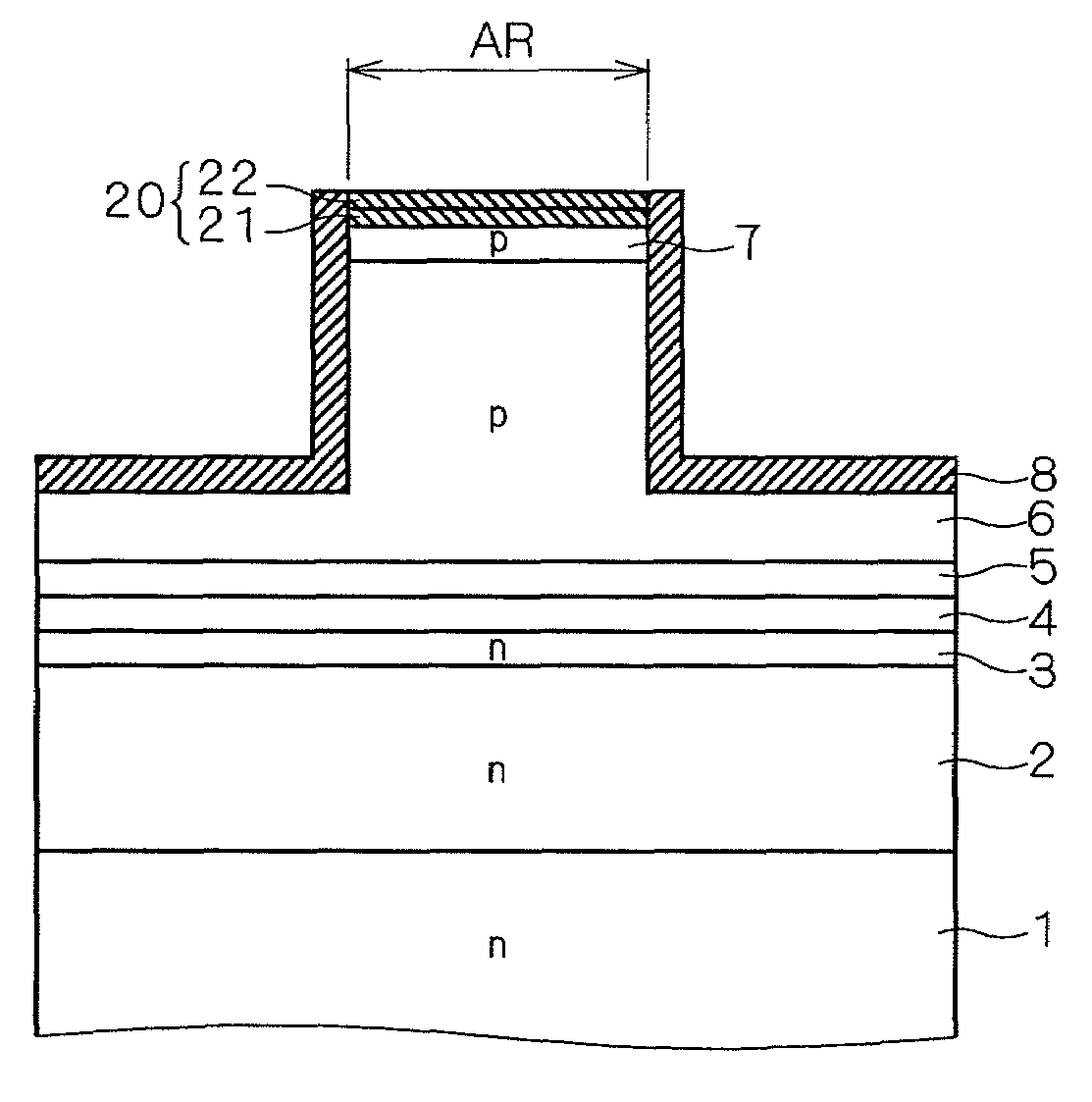Method of manufacturing semiconductor device including gallium-nitride semiconductor structure and a palladium contact
a gallium-nitride and semiconductor technology, applied in semiconductor devices, lasers, semiconductor devices, etc., can solve the problems of difficult to achieve a low-resistance p-type semiconductor layer, and often considered insufficient as a layered structure for long-term stable operation. , to achieve the effect of long-term stable operation and no degradation of device performan
- Summary
- Abstract
- Description
- Claims
- Application Information
AI Technical Summary
Benefits of technology
Problems solved by technology
Method used
Image
Examples
first preferred embodiment
[0020]FIGS. 1 to 6 are cross-sectional views illustrating a method of manufacturing a GaN-based semiconductor device (semiconductor laser diode) according to a first preferred embodiment of the invention. Referring to these drawings, a manufacturing process in the method of manufacturing a semiconductor device according to the first preferred embodiment is described below.
[0021]First, as shown in FIG. 1, a layered structure (semiconductor structure) including an n-type AlGaN cladding layer 2, an n-type GaN guide layer 3, an InGaN quantum-well active layer 4, a GaN guide layer 5, a p-type AlGaN cladding layer 6, and a p-type GaN contact layer 7 is formed on an n-type low-resistance GaN substrate 1.
[0022]The n-type AlGaN cladding layer 2 is a layer for carrier and optical confinement, and the n-type GaN guide layer 3 is a layer for light propagation. The n-type GaN guide layer 3 may be replaced with an n-type InGaN guide layer.
[0023]The InGaN quantum-well active layer 4 is a light-emi...
second preferred embodiment
[0041]FIG. 7 is a cross-sectional view illustrating part of a method of manufacturing a GaN-based semiconductor device (semiconductor laser diode) according to a second preferred embodiment of the invention. Referring now to FIG. 7, a manufacturing process in the method of manufacturing a semiconductor device according to the second preferred embodiment is described.
[0042]After the steps of the first preferred embodiment in FIGS. 1 to 3, then as shown in FIG. 7, a metallic compound 19, which is also an oxide, is formed on the surface of the p-type GaN contact layer 7 by a deposition of a metallic compound that contains oxygen or both oxygen and nitrogen, such as GaO, RuO, PdO, GaON, RuON, or PdON.
[0043]Then, through the steps of the first preferred embodiment in FIGS. 5 and 6, the same processing as described in the first preferred embodiment is performed, completing the manufacture of a GaN-based semiconductor device according to the second preferred embodiment. It is noted herein ...
third preferred embodiment
[0050]FIG. 8 is a cross-sectional view illustrating part of a method of manufacturing a GaN-based semiconductor device according to a third preferred embodiment of the invention. Referring now to FIG. 8, a manufacturing process in the method of manufacturing a semiconductor device according to the third preferred embodiment is described.
[0051]After the steps of the first preferred embodiment in FIGS. 1 to 3, then as shown in FIG. 8, an oxide film 21 is formed on the surface of the p-type GaN contact layer 7 by oxidation of the surface of the p-type GaN contact layer 7 with the supply of an oxygen-containing gas such as O2, O3, NO, N2O, or NO2.
[0052]Further, a metallic compound 22 is formed on the oxide film 21 by a deposition of a metallic compound that contains oxygen or both oxygen and nitrogen such as GaO, RuO, PdO, GaON, RuON, or PdON. These oxide film 21 and the metallic compound 22 form a layered oxide structure 20.
[0053]After that, through the steps of the first preferred emb...
PUM
 Login to View More
Login to View More Abstract
Description
Claims
Application Information
 Login to View More
Login to View More - R&D
- Intellectual Property
- Life Sciences
- Materials
- Tech Scout
- Unparalleled Data Quality
- Higher Quality Content
- 60% Fewer Hallucinations
Browse by: Latest US Patents, China's latest patents, Technical Efficacy Thesaurus, Application Domain, Technology Topic, Popular Technical Reports.
© 2025 PatSnap. All rights reserved.Legal|Privacy policy|Modern Slavery Act Transparency Statement|Sitemap|About US| Contact US: help@patsnap.com



